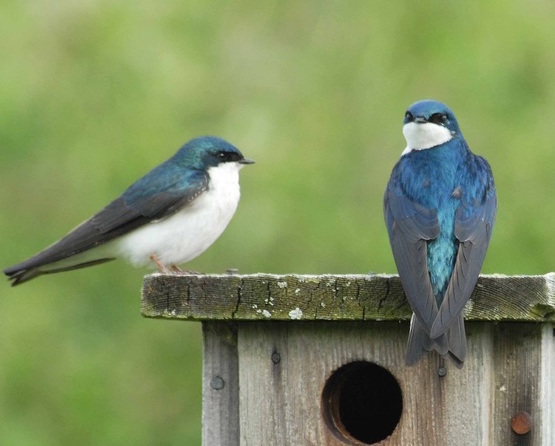 This week, we hear from 2019 Best Horse Practices Summit presenter Alayne Blickle.
This week, we hear from 2019 Best Horse Practices Summit presenter Alayne Blickle.
Alayne travels internationally to promote her work around Clean Water for Horses. At the Summit, she will present on an array of concerns surrounding horse property management.
Here, she writes about how birds help us keep down insect around the farm. Read her article on Mud Management here.
Blickle writes:
Every horse person loves this time of year. What gives us great hope for summer is the return of swallows to North America. Depending on where you live, you’ll start seeing swallows as early as March and April. Their cheery twitterings, which can brighten even a grey day, mark their return from Central America where they overwinter.
Several types of swallows are native to North America including violet-green swallows, tree swallows, barn swallows and cliff  swallows. What can be particularly exciting to horse owners is that swallows are voracious insect eaters. These slender little birds, about five or six inches in length, with pointed wings and tails, eat around 800 insets per bird per day. Multiply that by two for a nesting pair and over a period of weeks you have excellent insect control without ever having to buy anything (outside of a nest box or two) nor use chemicals.
swallows. What can be particularly exciting to horse owners is that swallows are voracious insect eaters. These slender little birds, about five or six inches in length, with pointed wings and tails, eat around 800 insets per bird per day. Multiply that by two for a nesting pair and over a period of weeks you have excellent insect control without ever having to buy anything (outside of a nest box or two) nor use chemicals.
Cliff and barn swallows build mud nests on the underside of roofs, overhands, bridges, cliffs – and in barns. If droppings become a problem for your situation place a board under the nest to keep the area clean.
Violet-greens and tree swallows are secondary cavity dwellers, meaning they nest in already created holes and crevices such as those in dead trees and snags or those made by woodpeckers. Happily for us, they also take very well to nest boxes. Nest boxes for violet-greens and tree swallows are easy to build or buy and hang in your yard or horse property–and these birds are easily attracted to them.
Note: nesting boxes must be specific to the type of swallows in your area. Poorly made boxes encourage non-native species, such as starlings, to move in which can out-compete swallows and other natives. Consult your local Audubon chapter, birding organization, cooperative extension office, the library or the internet for advice on the types and sources of nesting boxes.
The springtime return of swallows conveniently coincides with shedding season. During grooming sessions, collect horse and dog hair to set out in tuffs in your pasture area. Then, once nesting season commences in April and May, the swallows will begin recycling that hair into nesting material.
Check out this site for tree swallow nesting boxes and more.
These pretty little birds can provide horse owners with entrainment through their graceful flight acrobatics as they swoop to pick up nesting material and dart about catching insects, as well as a season’s worth of free, non-toxic pest control.
Interested in another non-toxic pest control? Check out tiny Fly Predators from Spalding Labs.
Love watching swallows dive bomb and quickly change direction as they grab bugs as I’m mowing. We also are blessed with a returning pair of Phoebe’s every year (for at least the past 15-20 years) who recommission a nest in the barn. Often they will have a second clutch of eggs (in a different nest) as well in early summer. They are “bug-catchers” too!!
the swallows are back this year in my barn busy as ever, the only one annoyed is the barn cat who has to duck their dive bombing her…they are fairly safe of her until they do that…get too to her head and therefore her outreached paw Most of the time they are safe of her swing
. But we have many every year so they remain abundant!